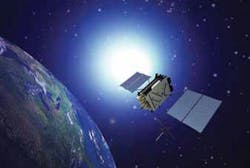Officials of the U.S. Air Force Research Laboratory Space Vehicles Directorate at Kirtland Air Force Base, N.M., have awarded contracts to the Boeing Space & Intelligence Systems segment in El Segundo, Calif., and to Ball Aerospace in Boulder, Colo., to design new L-band radio frequency power amplifiers for the GPS satellite navigation payload.
Boeing and Ball join the Northrop Grumman Corp. Aerospace Systems segment in Redondo Beach, Calif., on the Air Force Research Lab project that seeks to make GPS satellites smaller and more power efficient. Boeing won a $4.5 million contract on 6 June, while Ball won a $2.2 million contract on 14 May. Northrop Grumman won a $7 million contract this week.
The three companies are working to demonstrate the direct digital synthesis of GPS signals by designing a digital beam forming element, engineering design unit, and other enabling technologies of the digital phased array GPS payload.
Related: Honeywell to upgrade embedded navigation systems that combine GPS and inertial
Direct digital synthesis is a way of producing an analog signal in digital form and then performing a digital-to-analog conversion. Because operations primarily are digital, this process can offer fast switching between output frequencies, fine frequency resolution, and operation over a broad spectrum of frequencies.
With advances in design and process technology, today’s direct digital synthesis devices are compact and draw little power. This process can provide agile sources of low-phase, noise-variable frequencies with good spurious performance for GPS navigation signals, communications, and other RF and microwave applications.
Direct digital synthesis is gaining a reputation for generating analog signals efficiently because today's single-chip integrated circuits can generate programmable analog output waveforms simply and with high resolution and accuracy.
Related: GPS and eLoran timing receiver for navigation test and measurement introduced by Chronos
Continuing improvements in integrated circuit process technologies have helped reduce the costs and power consumption of integrated circuits for direct digital synthesis.
For more information contact Boeing Space & Intelligence Systems online at www.boeing.com, Ball Aerospace at www.ballaerospace.com, Northrop Grumman Aerospace Systems at www.northropgrumman.com, or the Air Force Research Laboratory Space Vehicles Directorate at www.kirtland.af.mil/afrl_vs.



